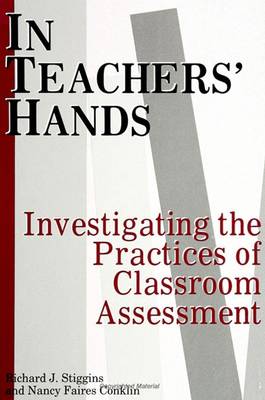
- Afhalen na 1 uur in een winkel met voorraad
- Gratis thuislevering in België vanaf € 30
- Ruim aanbod met 7 miljoen producten
- Afhalen na 1 uur in een winkel met voorraad
- Gratis thuislevering in België vanaf € 30
- Ruim aanbod met 7 miljoen producten
Zoeken
In Teachers' Hands
Investigating the Practices of Classroom Assessment
Richard J Stiggins, Nancy Faires Conklin
€ 53,45
+ 106 punten
Omschrijving
This book marks the starting point of a profound shift in assessment priorities, detailing the results of a decade-long program of research on classroom assessment environments. It demonstrates how important sound classroom assessments are to student well-being, and provides insights into the complex demands of day-to-day classroom assessment on teachers who have been taught little about assessment in their training programs.
As a nation, we spend billions of dollars on educational assessment, including hundreds of millions for international and national assessments, and additional hundreds of millions for statewide testing programs. On top of these, the standardized tests that form the basis of district-wide testing programs represent a billion dollar industry. If we total all of these expensive highly-visible, politically-important assessments, we still account for less than one percent of all the assessments conducted in America's schools. The other 99 percent are conducted by teachers in their classrooms on a moment-to-moment, day-to-day, and week-to-week basis. Paradoxically, virtually all of our national, state, and local assessment resources are being devoted to research and development for large-scale assessments. This book provides specific action programs for improving the quality of the other 99 percent--the assessments that really drive what students learn and how they feel about it.
As a nation, we spend billions of dollars on educational assessment, including hundreds of millions for international and national assessments, and additional hundreds of millions for statewide testing programs. On top of these, the standardized tests that form the basis of district-wide testing programs represent a billion dollar industry. If we total all of these expensive highly-visible, politically-important assessments, we still account for less than one percent of all the assessments conducted in America's schools. The other 99 percent are conducted by teachers in their classrooms on a moment-to-moment, day-to-day, and week-to-week basis. Paradoxically, virtually all of our national, state, and local assessment resources are being devoted to research and development for large-scale assessments. This book provides specific action programs for improving the quality of the other 99 percent--the assessments that really drive what students learn and how they feel about it.
Specificaties
Betrokkenen
- Auteur(s):
- Uitgeverij:
Inhoud
- Aantal bladzijden:
- 271
- Taal:
- Engels
- Reeks:
Eigenschappen
- Productcode (EAN):
- 9780791409329
- Verschijningsdatum:
- 1/07/1992
- Uitvoering:
- Paperback
- Formaat:
- Trade paperback (VS)
- Afmetingen:
- 152 mm x 229 mm
- Gewicht:
- 390 g

Alleen bij Standaard Boekhandel
+ 106 punten op je klantenkaart van Standaard Boekhandel
Beoordelingen
We publiceren alleen reviews die voldoen aan de voorwaarden voor reviews. Bekijk onze voorwaarden voor reviews.











